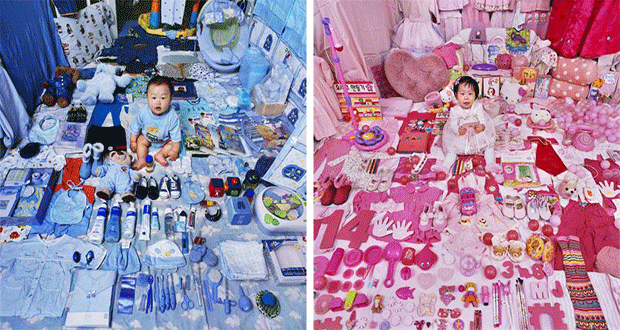
Color coded programming?
The debate around sex and gender always revolves around physical differences in the male/female body/brain. People who want to believe that there are essential differences between boys and girls try and find evidence that differences are rooted in the physical body, while those very few who argue there are no differences (like I do in the LP corpus), look for evidence that there is no significant physical difference. Speaking of the evidence, research is starting to demonstrate quite conclusively that there are relatively few differences between men and women. For example, a recent article incorporated here finds no differences between the male and female physical brain! As the evidence mounts that there are no structural differences in the brains of male and female humans, proponents of essentialism will look for other evidence to support their theories.
The most promising evidence for essentialists comes from research on the endocrine (hormone) system of the human body. The evidence for gender difference here is strong! That is, there is no denying that there are clear differences in the way men and women both produce and react to hormones in the body. Essentialists of all stripes will try and convince you that the differences are rooted in different biology, or different genetics, but I’m not convinced. Just as there is strong evidence that men and women do react to hormones differently, there is also incredibly strong evidence to show that these hormone differences are environmentally based! Consider this article by Jou (2012). This article is written by electrical engineers developing what they call “physiologically friendly” light sources. Engineers are looking to develop physiologically friendly light sources because of the way even small levels of light impact hormone production and usage. The authors themselves reference the established fact that low levels of “cool light” interfere with the production of melatonin (a powerful hormone that impacts sleep cycles, amongst other things), while warm light encourages it. They report the development of an LED that provides a color temperature (CT) lower than that of even candles, but that still provides enough light to read by! They are doing this because of how toxic high CT (color temperature) light is to the pre-somnambulant human body.
There is a lot of evidence to show that something as seemingly benign as light has a major impact on biological systems, endocrine systems, and even the systems of plants (Brüning et al. 2016, Kulikov and Popova 2015, Yadav and Chaturvedi 2015, Hassan et al. 2013), and the evidence is mounting. So where does this leave the essentialists who want to argue that gender is rooted in biological (or even divine) predestination? If you ask me, on pretty shaky ground. Not only is mounting evidence not in their favor, but from the very moment you are born, your environment is subject to intensive environmental manipulation overtly designed to program your body’s gender! Don’t believe me? The next time you see a baby being born, ask yourself why the nurse wraps the baby girls in pink (thus reflecting pink light into the girl’s tiny eyes) and the baby boys in blue? Also ask yourself what the impact of years of this sort of “light conditioning” might be on an infant’s endocrine system. If you take a snapshot of endocrine function at the age of 20, can you really say that what you observe is a natural difference between boys and girls. The answer is, you cannot. In fact, until we stop manipulating our children with environmental interventions designed to program children based on their genitalia, we will never be able to tell for sure whether gender is just a figment of our collective imagination, or a reality rooted in real and significant physical differences between boys and girls.
References
Brüning, Anika, Franz Hölker, Steffen Franke, Wibke Kleiner, and Werner Kloas. 2016. “Impact of different colours of artificial light at night on melatonin rhythm and gene expression of gonadotropins in European perch.” Science of the Total Environment 543 (Part A):214-222. doi: 10.1016/j.scitotenv.2015.11.023.
Hassan, Md Rakibul, Shabiha Sultana, Choe Ho Sung, and Ryu Kyeong Seon. 2013. “Effect of monochromatic and combined light colour on performance, blood parameters, ovarian morphology and reproductive hormones in laying hens.” Italian Journal of Animal Science 12 (3):359-364. doi: 10.4081/ijas.2013.e56.
Jou, Jwo-Huei, (2012). Organic light-emitting diode-based plausibly physiologically-friendly low color-temperature night light Organic Electronics: (8). 1566-1199
Kulikov, A. V., and N. K. Popova. 2015. “Tryptophan hydroxylase 2 in seasonal affective disorder: underestimated perspectives?” Rev Neurosci. doi: 10.1515/revneuro-2015-0013.
Yadav, Suneeta, and Chandra Mohini Chaturvedi. 2015. “Light colour and intensity alters reproductive/seasonal responses in Japanese quail.” Physiology & Behavior 147:163-168. doi: http://dx.doi.org/10.1016/j.physbeh.2015.04.036.